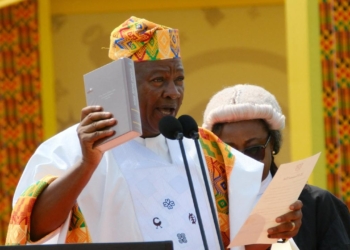A Sustainable Land and Water Management (SLWM) project in Ghana’s northern savannah zone is
contributing to enhanced food security and increased climate resilience of the beneficiary communities.
The World Bank’s Global Environment Facility (GEF) has in the past five years offered a grant of close to $30million to scale-up SLWM interventions to support forest fringe communities.
With focus on root and tuber cultivation, the SLWM interventions are helping to expand an original 6,000 hectares to 15,000 hectares.
“The farmers are truly involved in adopting sustainable land and water management practices, banding, terracing and provides options for alternative livelihoods in the dry seasons,” observed Gayatri Kanungo, Senior Environmental Specialist at the World Bank Group and Manager of the TerrAfrica Leveraging Fund.
The TerrAfrica Leveraging Fund provides a flexible financing mechanism to support activities under the TerrAfrica programme that have the potential for scaling up sustainable land and water management in SSA countries.
Over the decade, the Fund has supported several countries in leveraging and designing innovative interventions in SLWM.
Support was provided for the development of the Ghana Strategic Investment Framework, which helped integrate all planned SLM activities for investment generation.
The country has used the Framework to implement landscape approaches of bringing the sectors together under a sustainable land management committees led by the Ministry of Environment, Science, Technology and Innovation.
The TerrAfrica programme currently gives support to 29 countries in sub-Saharan Africa in policy and investments needed to address land degradation and desertification.
In Ghana, the programme has provided the opportunity to implement SLWM projects, which bring together the sectors of forests, agricultural lands and protected area biological corridors.
Projects are community-driven, considering the option of looking at various land users are impacting and generating benefits for the communities in the Northern Savanah, which are characterized by vulnerability, low climate resilience, and high poverty.
According to Gayatri Kanungo, Ghana’s successful implementation of best practices in SLWM is becoming a showcase model to be replicated in other African countries.
TerrAfrica has however transformed from sustainable land management to landscapes management, which provides the means to make both the ecosystem and livelihoods of the people resilient.
“At the end of the day, it’s about supporting the livelihoods of African communities.… It’s about building the resilient capacity of African people both in terms of coping with change in weather patterns and economic resilience,” said Estherine Fotabong, the NEPAD Agency’s Director of Programme.
Project priorities under the TerrAfrica program are aligned with Ghana’s vision of modernizing its agricultural sector to improve food security in an environmentally sustainable manner with a focus on smallholder farmers, particularly in the most fragile ecosystems.
Sign up for Ghana Star News to receive daily email alerts of breaking news in Ghana. GhanaStar.com is your source for all Ghana News. Get the latest Ghana news, breaking news, sports, politics, entertainment and more about Ghana, Africa and beyond.

